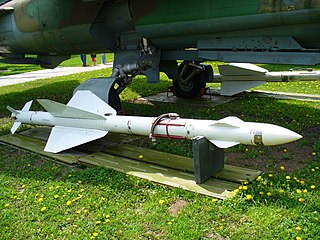
The AIM-7 Sparrow is an American, medium-range semi-active radar homing air-to-air missile operated by the United States Air Force, United States Navy, and United States Marine Corps, as well as other various air forces and navies. Sparrow and its derivatives were the West's principal beyond visual range (BVR) air-to-air missile from the late 1950s until the 1990s. It remains in service, although it is being phased out in aviation applications in favor of the more advanced AIM-120 AMRAAM.

An air-to-air missile (AAM) is a missile fired from an aircraft for the purpose of destroying another aircraft. AAMs are typically powered by one or more rocket motors, usually solid fueled but sometimes liquid fueled. Ramjet engines, as used on the Meteor, are emerging as propulsion that will enable future medium-range missiles to maintain higher average speed across their engagement envelope.
Semi-active radar homing (SARH) is a common type of missile guidance system, perhaps the most common type for longer-range air-to-air and surface-to-air missile systems. The name refers to the fact that the missile itself is only a passive detector of a radar signal—provided by an external ("offboard") source—as it reflects off the target. Semi-active missile systems use bistatic continuous-wave radar.

The Missile d’Interception, de Combat et d’Auto-défense or MICA is a French anti-air multi-target, all weather, fire-and-forget short and medium-range missile system manufactured by MBDA France. It is intended for use both by air platforms as individual missiles as well as ground units and ships, which can be equipped with the rapid fire MICA Vertical Launch System. It is fitted with a thrust vector control (TVC) system. It was developed from 1982 onward by Matra. The first trials occurred in 1991, and the missile was commissioned in 1996 to equip the Rafale and Mirage 2000. It is a replacement for both the Super 530 in the interception role and the Magic II in the dogfighting role.

The Vympel NPO R-77 missile is a Russian active radar homing beyond-visual-range air-to-air missile. It is also known by its export designation RVV-AE. It is the Russian counterpart to the American AIM-120 AMRAAM missile.

The RIM-116 Rolling Airframe Missile (RAM) is a small, lightweight, infrared homing surface-to-air missile in use by the German, Japanese, Greek, Turkish, South Korean, Saudi Arabian, Egyptian, Mexican, UAE, and U.S. Navies. It was originally intended and used primarily as a point-defense weapon against anti-ship missiles. As its name indicates, RAM rolls as it flies. The missile must roll during flight because the RF tracking system uses a two-antenna interferometer that can measure phase interference of the electromagnetic wave in one plane only. The rolling interferometer permits the antennas to look at all planes of incoming energy. In addition, because the missile rolls, only one pair of steering canards is required. As of 2005, it is the only U.S. Navy missile to operate in this manner.

The de Havilland Firestreak is a British first-generation, passive infrared homing air-to-air missile. It was developed by de Havilland Propellers in the early 1950s, entering service in 1957. It was the first such weapon to enter active service with the Royal Air Force (RAF) and Fleet Air Arm, equipping the English Electric Lightning, de Havilland Sea Vixen and Gloster Javelin. It was a rear-aspect, fire and forget pursuit weapon, with a field of attack of 20 degrees either side of the target.

The Kaliningrad K-8 (R-8) was a medium-range air-to-air missile developed by the Soviet Union for interceptor aircraft use.

The Hughes AIM-4 Falcon was the first operational guided air-to-air missile of the United States Air Force. Development began in 1946; the weapon was first tested in 1949. The missile entered service with the USAF in 1956.

The Vympel R-23 is a medium-range air-to-air missile developed by Vympel in the Soviet Union for fighter aircraft. An updated version with greater range, the R-24, replaced it in service. It is comparable to the American AIM-7 Sparrow, both in terms of overall performance as well as role.
A beyond-visual-range missile (BVR) is an air-to-air missile (BVRAAM) that is capable of engaging at ranges of 20 nmi (37 km) or beyond. This range has been achieved using dual pulse rocket motors or booster rocket motor and ramjet sustainer motor.

The 9K31 Strela-1 is a highly mobile, short-range, low altitude infra-red guided surface-to-air missile system. Originally developed by the Soviet Union under the GRAU designation 9K31, it is commonly known by its NATO reporting name, SA-9 "Gaskin". The system consists of a BRDM-2 amphibious vehicle, mounting two pairs of ready-to-fire 9M31 missiles.

Active radar homing (ARH) is a missile guidance method in which a missile contains a radar transceiver and the electronics necessary for it to find and track its target autonomously. The NATO brevity code for an air-to-air active radar homing missile launch is fox three.

Infrared homing is a passive weapon guidance system which uses the infrared (IR) light emission from a target to track and follow it seamlessly. Missiles which use infrared seeking are often referred to as "heat-seekers" since infrared is radiated strongly by hot bodies. Many objects such as people, vehicle engines and aircraft generate and emit heat and so are especially visible in the infrared wavelengths of light compared to objects in the background.

The Raytheon MIM-23 HAWK is an American medium-range surface-to-air missile. It was designed to be a much more mobile counterpart to the MIM-14 Nike Hercules, trading off range and altitude capability for a much smaller size and weight. Its low-level performance was greatly improved over Nike through the adoption of new radars and a continuous wave semi-active radar homing guidance system. It entered service with the US Army in 1959.

Bendix RIM-8 Talos was a long-range naval surface-to-air missile (SAM), among the earliest SAMs to equip United States Navy ships. The Talos used radar beam riding for guidance to the vicinity of its target, and semi-active radar homing (SARH) for terminal guidance. The four antennas surrounding the nose were SARH receivers, which functioned as a continuous wave interferometer. A solid rocket booster provided initial thrust for launch; a Bendix ramjet provided for flight to the target, with the warhead serving as the ramjet's compressor.
The Rainbow Codes were a series of code names used to disguise the nature of various British military research projects. They were mainly used by the Ministry of Supply from the end of the Second World War until 1958, when the ministry was broken up and its functions distributed among the forces. The codes were replaced by an alphanumeric code system.

The Matra R.530 is a French medium to short range air-to-air missile. It was available in infrared homing and semi active radar homing as the main armament of the Mirage III which was able to carry a single missile in the centerline, the Mirage F1, which carried two under the wings, and the F-8 Crusader, also carrying two on the sides of the fuselage in French Navy service.
An inverse monopulse seeker is a type of semi-active radar homing that offers significant advantages over earlier designs. The system requires electronics that can compare three signals at once, so this design did not become practically possible until the early 1970s. One of the first such examples was the Soviet Union R-40 air-to-air missiles used in MiG-25P introduced in service in 1970 and RAF's Skyflash missile introduced in 1978, an adaptation of the AIM-7 Sparrow that replaced the original Raytheon seeker with a monopulse model from Marconi, followed by a very similar conversion by Selenia for the Italian Aspide. The USAF adopted similar technology in the M model of the AIM-7 Sparrow, and such designs are universal in semi-active designs today.
Artemis, named for the Greek goddess of the chase and death, was an early air-to-air missile project carried out by the Royal Aircraft Establishment (RAE) beginning in late 1943. The missile was intended for radar-equipped night fighters like the Bristol Beaufighter, which would track the target on their AI Mk. IV radar and then fire at a set range, with the missile homing on the signal of the AI radar being reflected off the target.
















